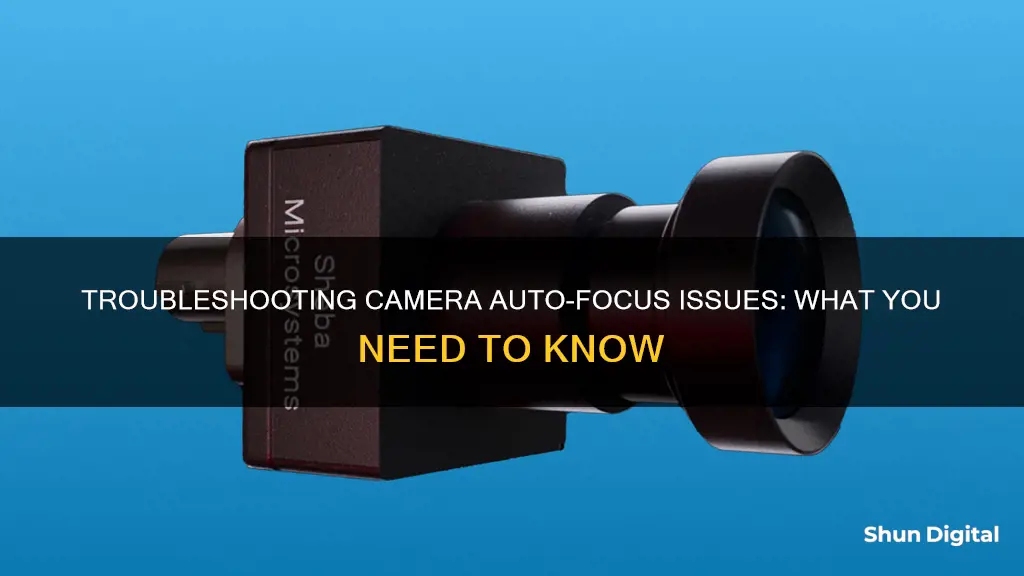
There are many reasons why your camera might not be auto-focusing. It could be that the lens isn't attached properly, or that the camera is set to manual focus instead of autofocus. It could also be that the autofocus system is confused due to lack of contrast or light, or that the lens is dirty or damaged. Other possible reasons include the camera being too close to the subject, or that the viewfinder is blurry.

Dirty lens contacts
If your camera isn't auto-focusing, one of the possible reasons could be dirty lens contacts. The camera and lens both have metal contacts that must be in communication with each other for the camera to function properly. If the lens isn't attached properly, the contacts may not be touching, and the camera can't send the lens the message to focus when you press the shutter button.
To check if this is the issue, remove the lens and remount it. You should hear a small click when it's locked into place. If you don't hear the click, try cleaning the contacts with a cotton swab and a drop of isopropyl alcohol. Once the lens is remounted, try the focus again.
If your lens still isn't focusing, there are a few other things you can try. First, check that your lens is set to autofocus (AF) and not manual focus (MF). This switch is usually on the side of the lens barrel. Next, make sure you aren't too close to your subject. Every lens has a minimum focus distance, and if you're closer than that, your camera and lens will struggle to focus. Simply backing up a little bit may solve the problem.
Another reason your camera may struggle to focus is low light. Your camera may struggle to find focus in low-light conditions. To solve this issue, try choosing a lens with a larger maximum aperture, as this will let in more light for your camera to see better. Alternatively, you can use a flash or a tripod to stabilize the camera and reduce camera shake.
Focusing LG G6 Camera: Tips and Tricks
You may want to see also

Wrong AF mode
One of the most common problems for consistently not getting a sharp image is that your camera is set to the wrong AF mode. For example, if you are photographing birds and are getting blurred images, check the active AF mode. If it is anything other than AF-C (or Continuous Servo AF), this could be the problem.
Different camera manufacturers use different terms for similar AF settings. For example, Single-Shot AF for Canon is AF-S for Nikon and Single-shot AF for Sony. This is the most basic option available and locks the focus on the subject you want to photograph. It is best used for static subjects, such as portraits, macro, and architecture.
Continuous autofocus (AF-continuous for Canon, AF-C for Nikon, and Continuous AF for Sony) is the best mode for moving subjects. Once you've set your focus, your camera will continue to track the subject, even if they move around within the frame.
Hybrid autofocus mode (AF-A for Nikon, AI Focus AF for Canon, and Continuous AF for Sony) is for when you're unsure whether to use single or continuous autofocus. It switches to AF continuous to track moving subjects and then switches back to AF single once they pause.
Choosing the AF mode should not be confused with choosing the AF area mode, which can also be set automatically or manually. The AF area mode determines where the camera will focus.
Charging Camera Batteries: Using the DigiPower Charger
You may want to see also

Low light
The human eye is far more advanced than a camera's autofocus sensor, and can adapt to low-light conditions much more quickly and effectively. The eye's pupil widens, and the cones and rods in the retina increase their sensitivity, allowing us to see in low light.
The autofocus sensor in a camera is also bound by the lens you are using. The lens splits the light that hits it, sending some to the viewfinder, and the rest to the autofocus sensor. The autofocus sensor then splits the light again, sending it to multiple autofocus points. This means that the autofocus sensor is only working with a small fraction of the light that enters the lens.
A lens with a large maximum aperture will let in more light, helping your camera to focus in low-light conditions. A 50mm f/1.8 or 35mm f/1.8 lens is a good choice for low-light photography.
Another option is to use a modern speedlight or flash commander with a built-in "AF assist" red beam. This will project a red beam onto your subject, allowing your lens to acquire focus. However, this method is only effective for subjects within 15-20 feet of the camera.
Fine-Tuning Your Axis Dome Camera for Optimal Focus
You may want to see also

Dirty AF sensors
To clean your AF sensor, set your camera to Sensor Cleaning Mode. Then, use a manual blower to dust the AF sensor. You can also use a lens brush and air to gently clean the AF sensor.
It is important to note that the AF sensor is different from the main image sensor. The AF sensor is located at the base of the camera, while the main sensor sits behind the mirror.
By keeping your AF sensor clean, you can ensure that your camera's autofocus system is functioning optimally.
In addition to dirty AF sensors, autofocus issues can also be caused by factors such as lens calibration, wrong autofocus mode, inaccurate autofocus viewfinder guides, heat refraction, dirty contacts, poor technique, and difficult subjects or wrong sensor choices. It is recommended to refer to your camera's manual to troubleshoot these issues effectively.
Latest Camera Raw: What's New in the Update?
You may want to see also

Lens needs calibrating
If your lens is consistently focusing in front of or behind the intended point of focus, it needs to be calibrated. This is a common issue with DSLR cameras, but it is rare with mirrorless cameras.
Lens calibration involves fine-tuning the autofocus system of your camera to ensure accurate and precise focus. Essentially, you are matching up the lens to the camera’s autofocus chip so that they are both seeing the same thing.
To calibrate your lens, you will need a calibration tool, a tripod (or another way to keep your camera steady and level), and your camera body and lens. You will also need a computer and monitor to review the images and really see where your focus is falling.
- Place your calibration tool on a flat surface in good light. You can do this outside if there’s no wind to blow your tool around. If you have one of the more sophisticated tools, you can mount it to a light stand.
- Mount your camera to your tripod and align the camera with the tool. Make sure your camera is level from side to side and front to back.
- Use the widest aperture you can. Also, make sure your lens is far enough away from the tool to account for your minimum focusing distance.
- Take your initial shot, focusing on the main focal point on the calibration tool. Then review that image on your computer.
- Evaluate the image for focus. Is your focus falling forward of your focus point? Or is it behind?
- Use your camera’s adjustment settings to fine-tune your focus. The exact menu settings and location will vary by camera, so consult your manual on how to fine-tune or make micro-focus adjustments.
- Once you have made your initial adjustment, take another picture and evaluate your focus. Repeat this process until you have the focus exactly where you want it.
It is important to note that this process only fixes one lens by matching it to the camera. Therefore, it is recommended to calibrate all your lenses.
The Evolution of Cameras: A Historical Timeline
You may want to see also
Frequently asked questions
There could be a number of reasons for this. Firstly, check that your camera is set to autofocus and not manual focus. Secondly, make sure your lens is attached properly and that the contacts between the lens and the camera are clean and not damaged. Finally, check that your camera has sufficient light and contrast to focus.
Most lenses have an AF/MF toggle switch on the side of the lens barrel. Make sure this is set to AF (autofocus). Some cameras also have a focus switch on the body, so check your camera body as well.
Remove and remount the lens. You should hear a small click when it's locked into place. If not, try cleaning the contacts between the lens and the camera with a lens cloth and a special cleaning solution.







